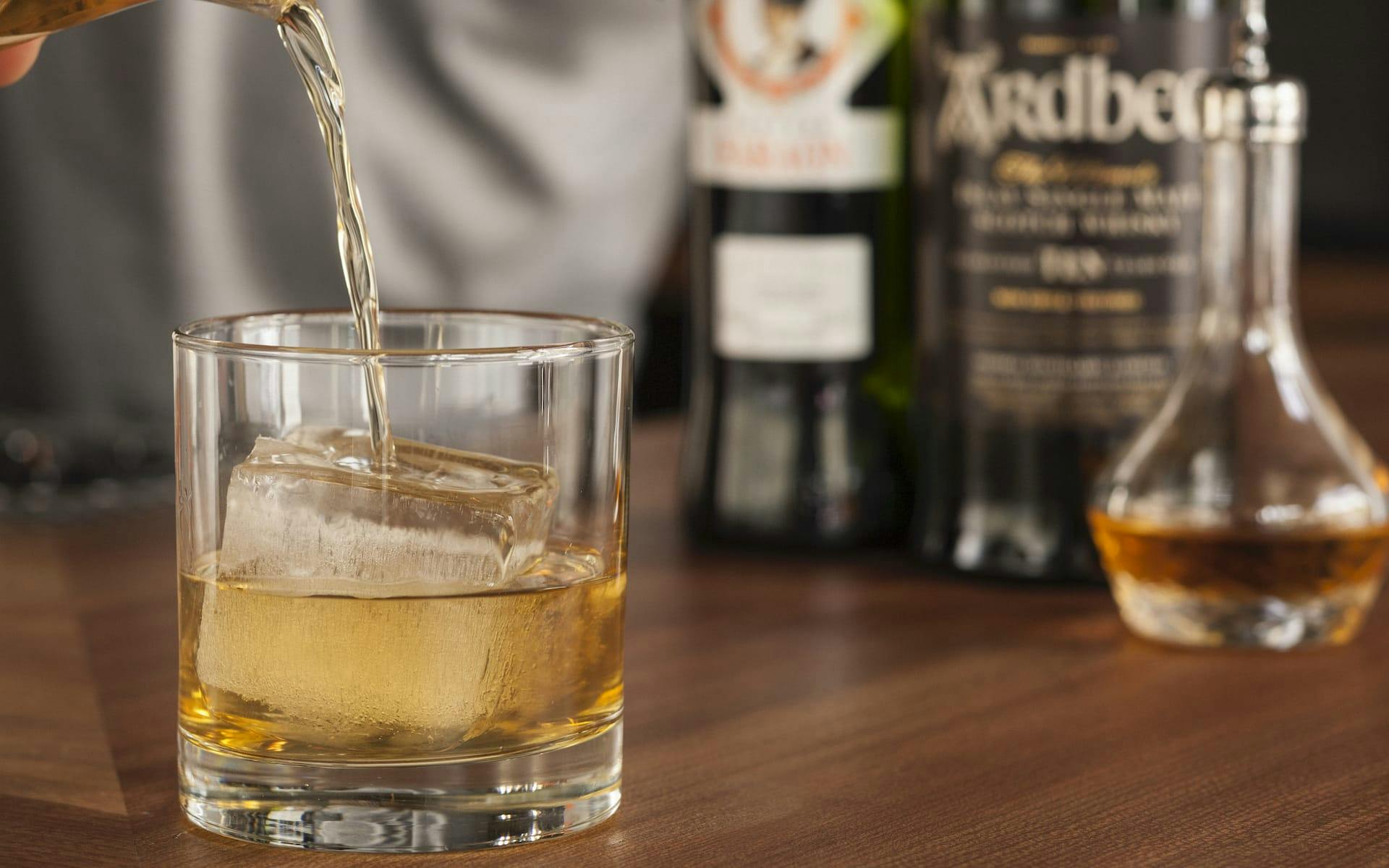If the last year has taught us anything, it’s self-reliance. As we’ve yearned for the days when restaurants and bars are open to full capacity, many of us have taken it upon ourselves to up our at-home games, whipping up decadent dinners (or trying to, at least) and mixing craft cocktails.
Whether you’ve already elevated your home bartending skills or just feel inspired to do so, the following advice, offered by specialists at five heralded cocktail bars across California, will bring your at-home cocktail experiences to blissful new heights.
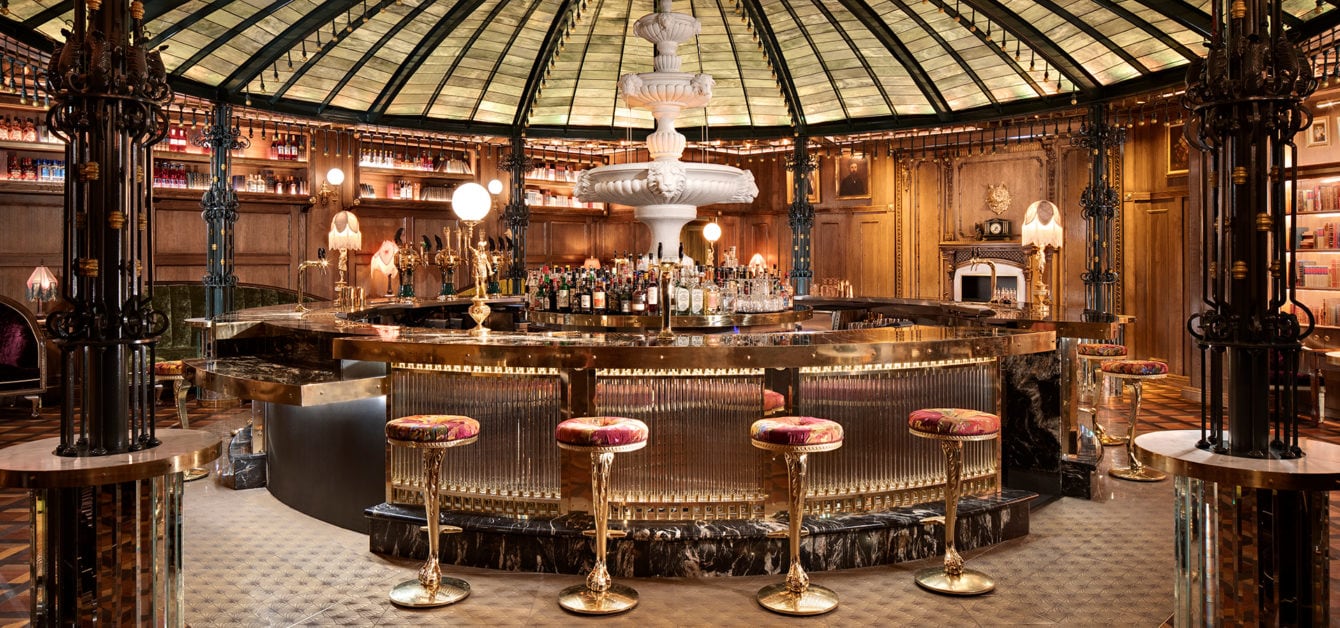
Regal Advice
When it comes to seeking at-home cocktail advice from professional bartenders, there’s no better sage than Tony Roehr, the lead bartender at Raised by Wolves in San Diego. “I don’t know many bartenders who make cocktails at home,” he says. “But I do. I’m obsessed with it.”
Obsession is the right word, since Roehr has dedicated the entirety of his refrigerator’s freezer space to the art of cocktail-making. He routinely places orders for perfectly clear ice, delivered in various shapes and sizes by Penny Pound Ice (the same purveyor that supplies his employer), and all of his glassware is chilled, including his mixing glass. In fact, that’s one simple practice that cocktail enthusiasts can implement to instantly elevate the libations that they shake or stir up at home. “If you want a really awesome well-made cocktail at home, chill your glassware,” Roehr says. “It makes such a huge difference when you serve a cocktail in a chilled glass. It just lasts longer, and you’ll be satisfied with it a lot longer.”
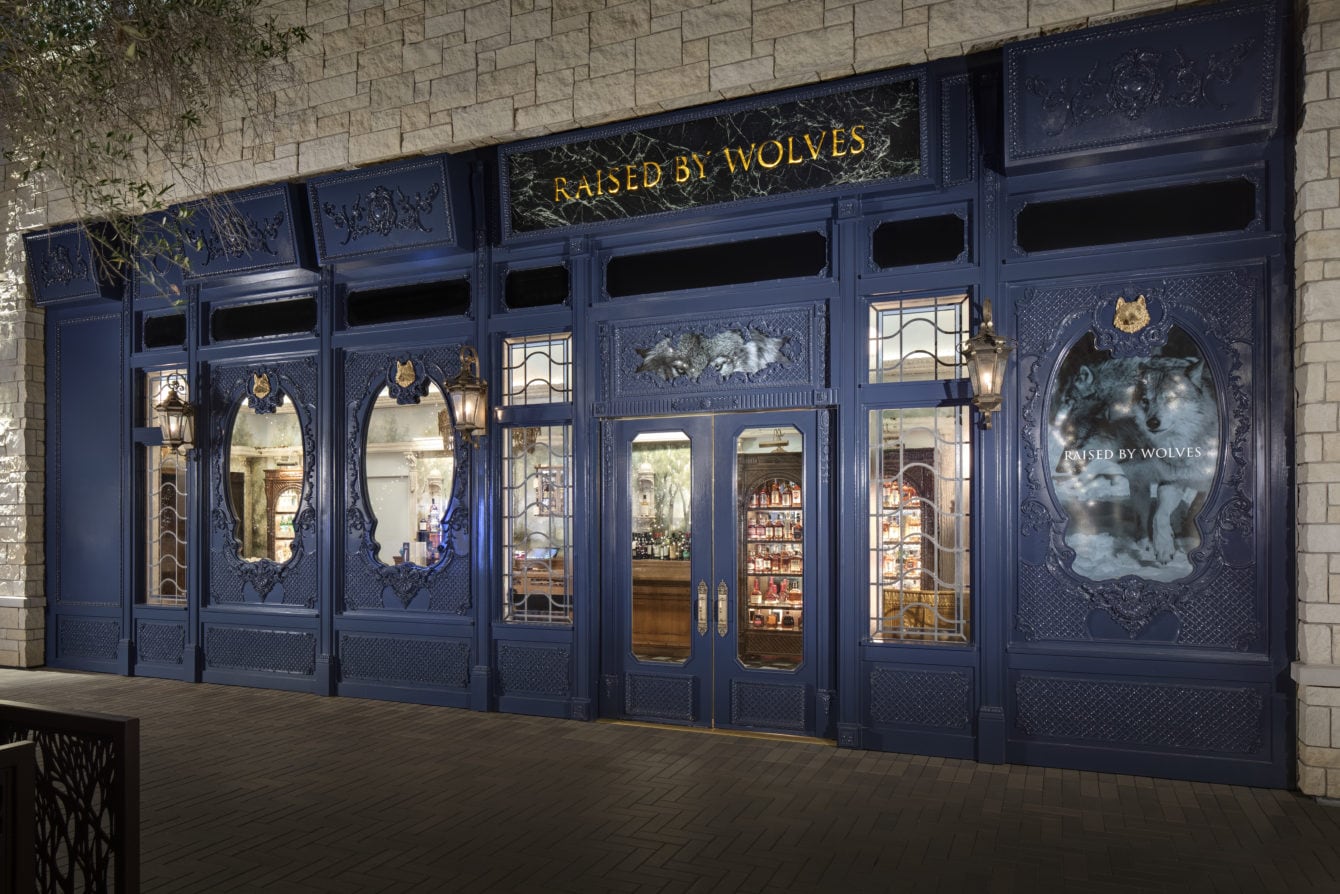
Roehr also urges at-home mixologists to experiment with the use of sherry, specifically Amontillado. “It can add so much character to a classic drink,” he says. “It can be in a refreshing cocktail made with a spirit, citrus and whatever sweetener you want and it really makes things pop, or you can sneak it into Manhattan variations.” On the latter point, Roehr typically starts with a Perfect Manhattan recipe (2 ounces of whiskey, ½ ounce of sweet vermouth, ½ ounce dry vermouth, 2 dashes Angostura bitters) and replaces the dry vermouth with an Amontillado sherry. (When adding sherry to bright citrus cocktails, Roehr recommends replacing ½ ounce of the base spirit with Amontillado.)
And if you’re shaking a cocktail that includes citrus juice, Roehr implores you to add to the shaker tin a thin, two-inch or three-inch slice of grapefruit peel (without the pith). This technique, known as a regal shake, was popularized by Milk & Honey, one of New York City’s pioneer craft cocktail bars during the early 2000s. “The amount of grapefruit oil [that’s drawn out of the peel] changes everything,” Roehr says. “There’s something about the grapefruit peel alone that really makes something pop.”

Worthy Investments
You’re likely familiar with the idiom “the devil is in the details,” but at the San Francisco bar ABV, the deliciousness is in the details. Behind the bar you’ll find only a collection of quality spirits and modifiers. Where a standard bar’s liquor well contains low-brow options or a string of labels branded with names you’ve never heard of, at ABV, owner and managing partner Ryan Fitzgerald only stocks the bar with spirits that he and his team would want to drink themselves. “Our drinks are really simple,” he says, “but by using unique and high-quality spirits, we can create a drink that tastes like nothing you’ve had before, and it might only have three or four ingredients.”
Fitzgerald is quick to add that home bartenders don’t need to break the bank when it comes to buying bottles for their own shelves, but they also shouldn’t put stock in the outdated philosophy that to mix a cocktail with a quality spirit is to waste that liquid. “If you’re a chef,” he says, “you’re going to use some of the best-quality food to make the best-quality dish. It’s the same thing at the bar.”

Adhering to that approach, Fitzgerald believes that cocktail enthusiasts should splurge on good vermouths—he likes all of the Dolin expressions, which are reasonably priced—but investing in good vermouth doesn’t mean buying a lot of it at one time. “Smaller bottles of vermouth are more expensive but a great idea for home bartenders, that way they don’t go bad,” he says, explaining that over a gradual period of time the vermouth in an open bottle will oxidize to a point that its characteristic flavors are muted.
Fitzgerald also encourages home bartenders to shake off any reservations they might have about mixing drinks at home, especially if they’re worried about making mistakes. “It’s not baking,” he says of cocktail-making. “It’s more like cooking, where you can salvage most mistakes. So taste a drink as you go—just like in cooking—and keep adjusting what will make it taste better. At ABV, we’ve always strived to keep tweaking the drink until we find the right ingredients for it to taste the best. Sometimes a small tweak just changes everything.”
To mix up a complex but easy to execute cocktail in ABV’s style, try the Señora Sol below:

Señora Sol
- 1½ oz. Leopold Summer Gin
- 1 oz. La Gitana Manzanilla Sherry
- ¾ oz. Dolin Blanc vermouth
Combine all ingredients in a mixing glass with ice and give it a long stir. Strain into a chilled coupe glass with no garnish.
Switching Things Up
Venerable classic cocktails, so long as they’re made to exceptional standards, are the libations that tug strongest at Cache Bouren’s heartstrings. Bouren, who owns and works as the head bartender at Haberdasher in San Jose, believes that these classics are timeless for a reason. “A really well-made old fashioned, Sazerac, daiquiri, these are the drinks that I want to enjoy for the rest of my life,” he says.

But Bouren also points out that being loyally committed to those classics doesn’t come at the expense of creativity or interesting new flavors. Haberdasher is constantly experimenting with and introducing rifts on those classics, and that’s an approach that he strongly encourages every home bartender to embrace. Those modifications don’t have to be overly complicated or earth-shattering, either.
Sometimes the simple decision to use a different style of whiskey in a Manhattan, an old-fashioned or a Boulevardier can produce a drink that’s wildly complex and pleasing. “Having a blended Scotch is a great idea,” he says. “Using a blended Scotch in cocktails can bring some depth, smoke, earth—things that wouldn’t otherwise be there if you’re making a bourbon cocktail or a rye cocktail.”

Bouren doesn’t limit his experimentation to spirit substitutions within the same general category, and he doesn’t think home bartenders should either. But he echoes Fitzgerald’s advice at ABV, especially if you’re willing to dabble in unconventional techniques or pairings. “Substitute fearlessly,” he says, “but then taste it before you finish. Get in the habit of tasting things all the time. You’re starting to build a flavor library in your head that you can refer to later.”
Remember, you’re always striving to balance the core components of a cocktail: sweet and sour (when it comes to flavor) and strong and weak (when it comes to the alcohol strength of a base spirit, modifiers, and the proper amount of dilution). As a way of easily explaining how a bartender approaches the search for balance in cocktails, Bouren imagines each core component as a stick. “We’ve got four or five sticks, and we’re trying to learn how to lean these together to that they can all stand up together,” he says.

Keeping It Fresh
It’s understandable that patrons of Apotheke in Los Angeles would surmise that the cocktails created by the bar’s mixologists are alcoholic concoctions best left to the professionals. Apotheke’s bartenders are wearing lab coats, after all. While those drinks don’t contain many rare, complex alcohols and liqueurs, they do require the use of infused spirits, fresh herbs, exotic fruits and juices, and other house-made tinctures that are undeniably intimidating. “We want everything to have a bit of show and grandeur while also using the finest ingredients,” says Nicolas O’Conner, the bar’s mixology director. “I’ll start with a gimlet base and infuse the gin with black cardamom, for example. Then I’ll use blood orange juice and bring in dragonfruit. I’ll just keep building and balancing and going over the top.”
That may be the foundation of Apotheke’s cocktail program, but it’s not as off-limits to home bartenders as one might think. In fact, the bar just published its first cocktail book, which provides guidance for making many of its libations at home. A measured jigger and a muddler are two bar tools that every amateur bartender should have, and they’re instrumental when taking on many of Apotheke’s recipes. From there, the first step, according to O’Conner, is to master a straightforward, classic cocktail recipe like a gimlet. To make a foundational gimlet, O’Conner starts with 2 ounces of gin and 1 ounce of a homemade sour mix (essentially a 1-to-1 ratio of fresh lime juice and simple syrup).
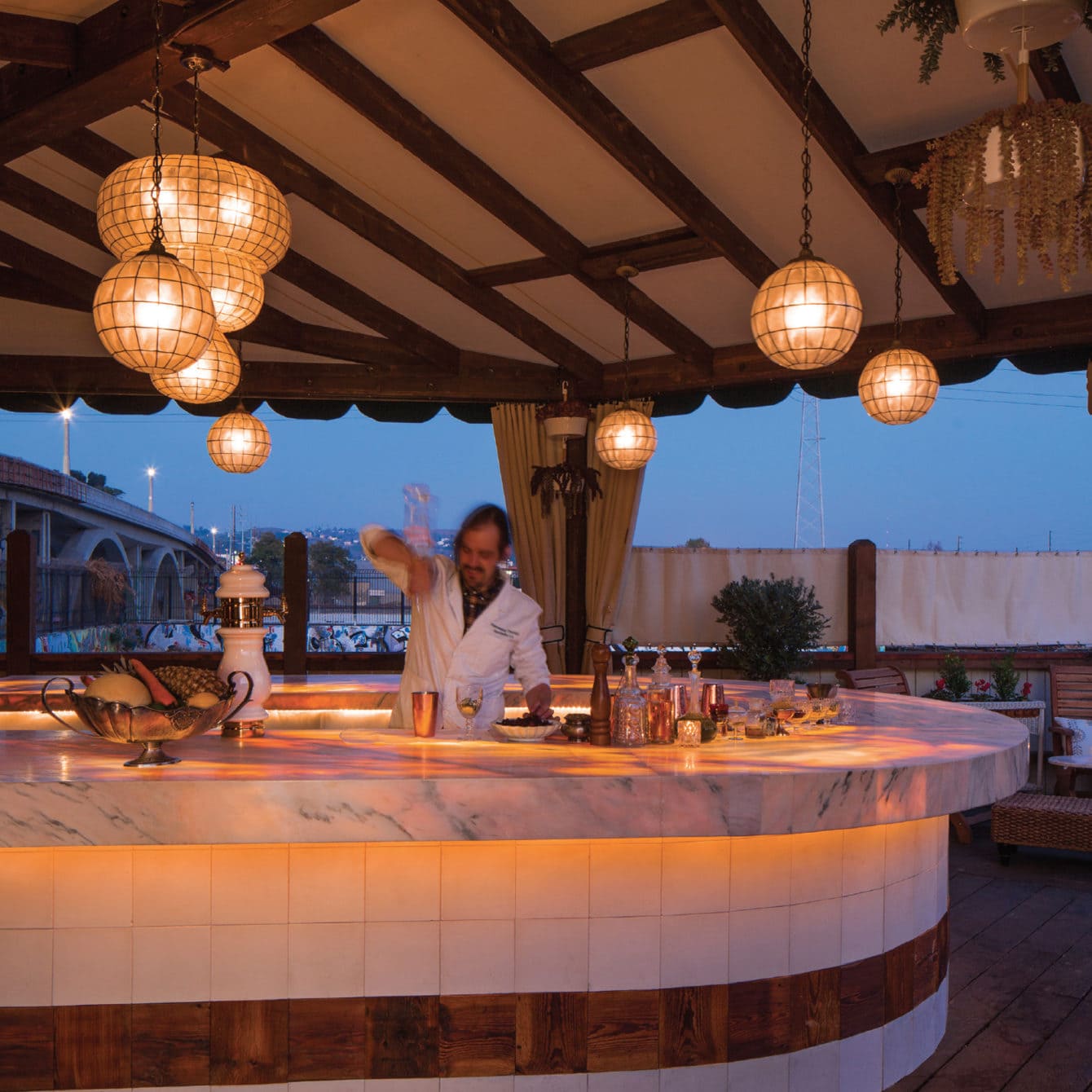
“Learn how to make a really good gimlet, and from there you can really experiment,” he says. “If you know how to make a gimlet and you continue to experiment with fun ingredients, you’ll continue to create really great-tasting and unique cocktails.”
As for infusing spirits, O’Conner acknowledges that it can be daunting, but those who try it at home can taste the infusion along the way to know when it’s finished. Loose leaf teas and dried herbs general require no more than an hour of steeping, while fresh herbs can require hours or even days to reach the right level of infused flavor. To create a basil-infused mezcal, for example, pour 8 ounces of mezcal into a measuring glass, add 7 grams of fresh basil leaves, and let it steep for 12 hours. Then strain the alcohol into a clean, airtight glass container. Similarly, to create a habanero tincture, pour 4 ounces of vodka into a measuring cup, add 8 grams of chopped habanero peppers (seeds removed), and let it steep for six hours. Then pour through a chinois strainer into a clean, airtight glass container.
With the two, aforementioned house-made ingredients at your disposal—along with a few other easily procured items—you can now make Apotheke’s Miracle of Mazunte, detailed below:
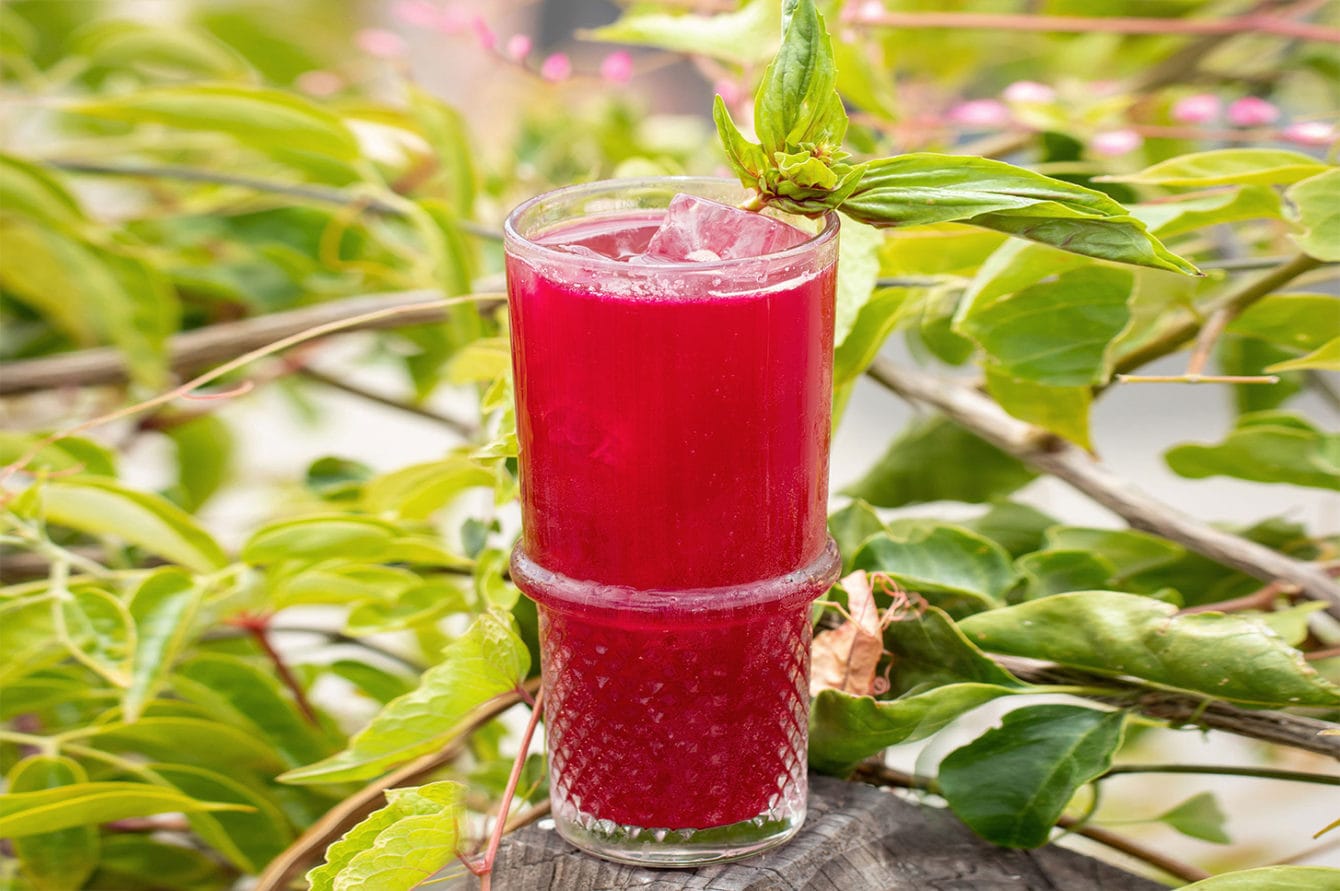
Miracle of Mazunte
- 2 oz. basil-infused mezcal
- 1 oz. beet juice
- ¾ oz. lime juice
- ½ oz. simple syrup
- 3 dashes habanero tincture
- 2 fresh basil leaves
- Club soda
Tear the basil leaves and add to a shaker tin. Add the measured ingredients and shake vigorously with ice. Add a 2-second pour of club soda and then strain ingredients into a Collins glass filled with fresh ice. Garnish with a whole basil leaf.
Tricks of the Tiki Trade
If you’ve ever stepped into Martin Cate’s tiki den Smuggler’s Cove in San Francisco and ordered a Top Notch Volcano, a Mastodon, or a Smuggler’s Rum Barrel—even if you’ve only seen photos that capture the bar’s ambiance and the whimsical Polynesian concoctions that Cate and his team create—you’re likely to think that whipping up a respectable, at-home recreation of those libations is a fool’s errand. Yet, appearances can be deceiving. “Part of the conceit of these drinks is that they are multi-layered, complex and have a lot of depth to them that takes the drinker on a bit of a journey,” Cate acknowledges. “The very point of them, in some respects, is that they’re complicated. And by their very nature and concept they’re labor intensive. It might seem daunting to the home bartender, but it’s really not that bad.”
To execute a tiki style drink that measure’s up to Smuggler’s Cove standards, you must first start with fresh squeezed citrus juice. “There isn’t a substitute for fresh lime juice,” Cate says. So return that bottle of Rose’s lime juice to the store shelf where you found it and bag some fresh limes. For God’s sake don’t buy one of those lemon-shaped plastic containers, either! (By the way, the merits of using fresh citrus juice extend to cocktails of all styles, not just tiki creations.)
Next, you’ll need to invest in at least two types of alcoholic modifiers: an allspice liqueur and a falernum. For the allspice liqueur, Cate points to St. Elizabeth Allspice Dram or Hamilton Jamaican Pimento Dram, the latter of which is created around a funky rum-based core. “Playing with both is certainly advised,” he says.

When it comes to falernum—a Caribbean liqueur with prominent ginger and clove notes—Cate always relies on John D. Taylor’s Velvet Falernum, which is made from a longstanding Barbadian recipe that is generally a bit milder than the falernums that are distilled by smaller craft producers. However, Cate acknowledges that a milder recipe works best for him because he’s crafting beverages that must appeal to a vast audience with a broad spectrum of tastes. On the topic of at-home tiki, the rules can change. “At the end of the day, this is your house,” he says. “You are making drinks for yourself. If you want to make a crazy clove tincture bomb, then terrific!”
On that topic, Cate urges home bartenders to experiment with different rums and different rum combinations, going so far as to create their own house blend. “Not only does it please you and hopefully pleases your guests, but it gives the drinks at your house their own flavor profile,” he says. “It allows you to put your own personal stamp on a drink.”

Finally, when it comes to actually making a tiki drink, Cate recommends using an electric drink mixer (Hamilton Beach sells models for less than $50.) “This tool is just fantastic for making classical tropical drinks,” he says. “It’s like a swizzle stick hooked up to a small block V8. It aerates, dilutes, and chills in three seconds. It’s so important to the history of the drinks and making them properly; and it’s the bar tool that we wish people would really invest in.”
If you’re eager to mix up an approachable classic tiki cocktail that delivers depth of flavor without a lot of work, try Cate’s Jamaican Planter’s Punch below. This recipe, along with more than 100 others, are included in Cate’s seminal tome on tiki culture and cocktails, and autographed copies can be purchased here.

Jamaican Planter’s Punch
- 3 oz. Appleton Estate Reserve 8 rum (or any other full-bodied Jamaican rum)
- 1 oz. fresh lime juice
- ¾ oz. Demerara syrup
- ¼ oz. St. Elizabeth Allspice Dram or Hamilton Jamaican Pimento Dram
- 2 dashes of Angostura bitters
If using a drink mixer: Combine all ingredients in a drink mixer tin with 12 ounces of crushed ice and flash blend for 3 seconds. Open pour all contents into a Collins glass. Alternatively, pour all ingredients into a shaker with cubed ice. Hand shake and strain into an ice-filled Collins glass. Garnish with a mint sprig and lime wedge.





